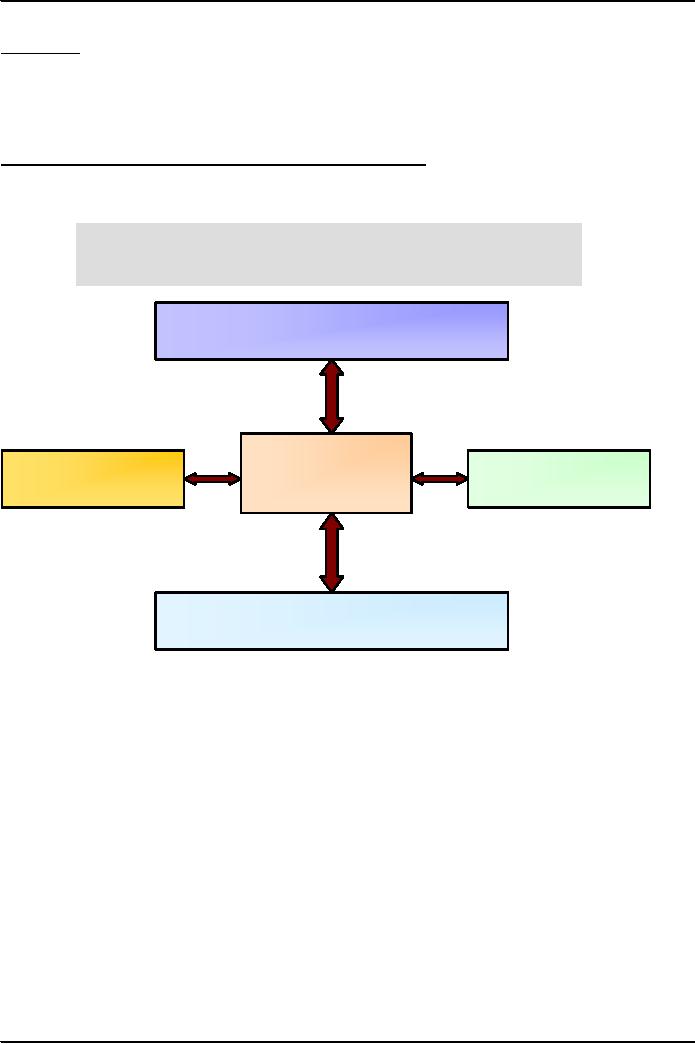 |
INDUSTRY ANALYSIS:Global challenge, The Competitive Profile Matrix (CPM) |
| << TECHNOLOGICAL FORCES:Technology-based issues |
| IFE MATRIX:The Internal Factor Evaluation (IFE) Matrix, Internal Audit >> |

Strategic
Management MGT603
VU
Lesson
11
INDUSTRY
ANALYSIS
Objectives:
The
EFE Matrix and five-force
model can help strategists
evaluate the market and
industry, but these
tools
must
be accompanied by good intuitive
judgment. Multinational firms especially
need a systematic and
effective
external-audit system because external
forces among foreign
countries vary so greatly. This
lecture
provides
you complete details of EFE
matrix as a component of SWOT
analysis.
Competitive
Intelligence Programs and competitive
analysis:
Systematic
and ethical process for
gathering and analyzing
information about the competition's
activities and general
business
trends
to further a business' own
goals.
Competitive
Analysis: Porter's Five-
Forces
Model
Potential
development
of
substitute products
Rivalry
among
Bargaining
power
Bargaining
power
Competing
firms
of
suppliers
of
consumers
Potential
entry of new
competitors
The
central point lays the
stress on rivalry of the competing firm.
This relates to the intensity of the
rivalry.
How
the firms compete with each
other and to what extent?
That should be taken into account
very
carefully.
Potential
entry for new competitors
shows a balance between
different firms competing in a market. It
also
refers
whenever a new partner enter
into a market he may become
threat for one and
opportunity for other
competing
partners. As all the new
entries and existing firms are competing
with each other so the
new
entry
will definitely make an effect on
every one transacting in the
market.
A
potential development of substitute products
also develops an environment of
competition in the market
among
the competing partners. As all firms want to
compete in term of quality and
substitute will lasts
for
longer
in the market if the quality of the
substitute will be greater than the
existing alternate. Other
factors
also
have a major impact on the
substitutes.
Collective
bargaining power of suppliers and
consumers: if vendors are
less in the market and
the
organizations
that have to purchase from
those vendors are more
then the demand for those
suppliers will
be
more as the firms have to purchase
from that less suppliers.
The reverse is the case if
suppliers are more
and
buyers are less. Then the
demand for those suppliers
will be less. Such
circumstances create
difficulties
in
bargaining.
These
above five components constitute the
basics elements for the
competitive analysis.
43

Strategic
Management MGT603
VU
Global
challenge:
International
Challenge faced by Pakistani
firms:
o
How
to gain and maintain exports to other
nations
o
How
to defend domestic markets against
imported goods
The
first challenge is the much
bigger in the sense that we
have to search for new
market and retain in
that
market
as the competition goes on increasing
with every passing second.
For this, we have to make
a
research
in the market that how to retain in
that market.
Second
challenge is also depends
upon the research that how
we can retain in that market
through
competition
and how to defend our market
with violation of exports
laws.
Industry
Analysis: The External Factor Evaluation
(EFE) Matrix
We
can prepare EFE matrix after
evaluating the key external factors
discuss in the later lectures. There
are
all
key factors which are
needed to be summarized in order to
make EFE matrix.
An
External
Factor Evaluation (EFE) Matrix
allows
strategists to summarize and
evaluate economic,
social,
cultural,
demographic, environmental, political, governmental,
legal, technological, and
competitive
information.
The EFE matrix consists of
five steps process.
Five-Step
process:
�
List
key external factors (10-20)
Opportunities
& threats
You
have to prepare a list of
all external factors which
will affect the EFE matrix.
These factors should be
two
points to be kept in mind
these are opportunities and
threats.
�
Assign
weight to each (0 to
1.0)
Sum
of all weights = 1.0
Now
you have to arrange them
according to their weight age
that which factor is most
important. It should
be
weight age in % ages. The
sum of the total of all the
factors should always be
one.
�
Assign
1-4 rating to each
factor
�
Firm's
current strategies response to the factor:
how well firms response to
these factors.
�
Multiply
each factor's weight by its
rating
�
Produces
a weighted score
How
the firm will respond to
these factors external factors.
Such criteria are known as
rating.
�
Sum
the weighted scores for
each
Determines
the total weighted score for the
organization.
�
Highest
possible weighted score for the
organization is 4.0; the lowest, 1.0.
Average = 2.5
Illustrated
in Table 3-11, the EFE Matrix
can be developed in five
steps:
1.
List key external factors as
identified in the external-audit process.
Include a total of from ten
to
twenty
factors, including both
opportunities and threats affecting the
firm and its industry.
List the
opportunities
first and then the threats.
Be as specific as possible, using
percentages, ratios,
and
comparative
numbers whenever
possible.
2.
Assign to each factor a weight
that ranges from 0.0
(not important) to 1.0 (very
important). The
weight
indicates the relative importance of that
factor to being successful in the firm's
industry.
Opportunities
often receive higher weights than
threats, but threats too
can receive high weights
if
they
are especially severe or threatening.
Appropriate weights can be determined by
comparing
successful
with unsuccessful competitors or by
discussing the factor and
reaching a group
consensus.
The sum of all weights
assigned to the factors must
equal 1.0.
3.
Assign a 1-to-4 rating to
each key external factor to indicate
how effectively the firm's current
strategies
respond to the factor, where 4 5
the
response is superior, 3 5
the
response is above average, 2 5
the
response
is average, and 1
5 the
response is poor. Ratings
are based on effectiveness of the
firm's
strategies.
Ratings are, thus, company
based, whereas the weights in
Step 2 are industry based.
It is
important
to note that both threats
and opportunities can
receive a 1, 2, 3, or 4.
4.
Multiply each factor's weight by
its rating to determine a
weighted score.
5.
Sum the weighted scores for
each variable to determine the total
weighted score for the
organization.
44

Strategic
Management MGT603
VU
An
Example External Factor Evaluation
Matrix for UST,
Inc.
WEIGHTED
KEY
EXTERNAL FACTORS
WEIGHT
RATING
SCORE
Opportunities
1.
Global markets are practically untapped
by
.15
1
.15
smokeless
tobacco market
2.
Increased demand caused by
public banning of
.05
3
.15
smoking
3.
Astronomical Internet advertising
growth
.05
1
.05
4.
Pinkerton is leader in discount tobacco
market
.15
4
.60
5.
More social pressure to quit
smoking, thus
.10
3
.30
leading
users to switch to
alternatives
Threats
1.
Legislation against the tobacco
industry
.10
2
.20
2.
Production limits
on
tobacco
increases
.05
3
.15
competition
for production
3.
Smokeless tobacco market is
concentrated in
.05
2
.10
southeast
region of United States
4.
Bad media exposure from the
FDA
.10
2
.20
5.
Clinton administration
.20
1
.20
TOTAL
1.00
2.10
Regardless
of the number of key opportunities and
threats included in an EFE Matrix, the
highest possible
total
weighted score for an organization is 4.0
and the lowest possible
total weighted score is 1.0.
The
average
total weighted score is 2.5. A
total weighted score of 4.0
indicates that an organization is
responding
in
an outstanding way to existing opportunities
and threats in its industry.
In other words, the firm's
strategies
effectively take advantage of existing
opportunities and minimize the potential
adverse effect of
external
threats. A total score of
1.0 indicates that the firm's
strategies are not capitalizing on
opportunities
or
avoiding external threats.
An
example of an EFE Matrix is
provided in Table for UST,
Inc., the manufacturer of Skoal
and
Copenhagen
smokeless tobacco. Note that
the Clinton administration was considered
to be the most
important
factor affecting this industry, as indicated by the
weight of 0.20. UST was not
pursuing strategies
that
effectively capitalize on this
opportunity, as indicated by the rating of
1.01. The total weighted
score of
2.10
indicates that UST is below
average in its effort to
pursue strategies that
capitalize on external
opportunities
and avoid threats. It is
important to note here that
a thorough understanding of the
factors
being
used in the EFE Matrix is
more important than the
actual weights and ratings
assigned.
Total
weighted score of 4.0
=
Organization
response is outstanding to threats &
weaknesses
Total
weighted score of 1.0
=
Firm's
strategies not capitalizing on
opportunities or avoiding
threats
UST
(in the previous example), has a
total weighted score of 2.10
indicating that the firm is below
average
in
its effort to pursue
strategies that capitalize on external
opportunities and avoid
threats.
Note:
Understanding of
the factors used in the EFE
Matrix is more important
than the actual weights
and
ratings
assigned.
45

Strategic
Management MGT603
VU
This
is important to understand the factors
for which you are preparing
the EFE matrix than the weight
age
given
to the each factors.
The
Competitive Profile Matrix
(CPM)
The
Competitive Profile Matrix (CPM)
identifies a firm's major
competitors and their
particular strengths and weaknesses
in
relation
to a sample firm's strategic
position.
The
weights and total weighted
scores in both a CPM and
EFE have the same meaning.
However, the
factors
in a CPM include both internal
and external issues; therefore, the
ratings refer to strengths
and
weaknesses,
where 4 5 major strength, 3 5 minor
strength, 2 5 minor weakness,
and 1 5 major weakness.
There
are some important
differences between the EFE
and CPM. First of all, the critical
success factors in
a
CPM are broader; they do not
include specific or factual data
and even may focus on
internal issues. The
critical
success factors in a CPM
also are not grouped into
opportunities and threats as they
are in an EFE.
In
a CPM the ratings and total
weighted scores for rival firms
can be compared to the sample
firm. This
comparative
analysis provides important internal
strategic information.
A
sample Competitive Profile
Matrix is provided in Table. In this
example, advertising and global
expansion
are
the most important critical success
factors, as indicated by a weight of 0.20.
Avon's and L'Oreal's
product
quality is superior, as evidenced by a
rating of 4; L'Oreal's "financial
position" is good, as indicated
by
a rating of 3; Procter & Gamble is the
weakest firm overall, as indicated by a
total weighted score of
2.80.
A
Competitive Profile Matrix
AVON
L'OREAL
PROCTER&GAMBLE
CRITICAL
SUCCESS
WEIGHT
RATING SCORE RATING SCORE
RATING
SCORE
FACTORS
Advertising
0.20
1
0.20
4
0.80
3
0.60
Product
Quality
0.10
4
0.40
4
0.40
3
0.30
Price
Competitiveness
0.10
3
0.30
3
0.30
4
0.40
Management
0.10
4
0.40
3
0.30
3
0.30
Financial
Position
0.15
4
0.60
3
0.45
3
0.45
Customer
Loyalty
0.10
4
0.40
4
0.40
2
0.20
Global
Expansion
0.20
4
0.80
2
0.40
2
0.40
Market
Share
0.05
1
0.05
4
0.20
3
0.15
TOTAL
1.00
3.15
3.25
2.80
Note:
(1)
The ratings values are as
follows: 1 = major weakness, 2 = minor
weakness, 3 = minor strength, 4
=
major
strength. (2) As indicated by the total
weighted score of 2.8, Competitor 3 is
weakest. (3) Only
eight
critical
success factors are included
for simplicity; this is too few in
actuality.
Other
than the critical success factors
listed in the example CPM,
other factors often included in
this
analysis
include breadth of product line, effectiveness of
sales distribution, proprietary or patent
advantages,
location
of facilities, production capacity and
efficiency, experience, union relations,
technological
advantages,
and e-commerce
expertise.
A
word on interpretation: Just
because one firm receives a
3.2 rating and another
receives a 2.8 rating in
a
Competitive
Profile Matrix, it does not
follow that the first firm
is 20 percent better than the
second.
Numbers
reveal the relative strength of firms,
but their implied precision
is an illusion. Numbers are
not
magic.
The aim is not to arrive at a
single number but rather to assimilate
and evaluate information in
a
meaningful
way that aids in decision
making.
46
Table of Contents:
- NATURE OF STRATEGIC MANAGEMENT:Interpretation, Strategy evaluation
- KEY TERMS IN STRATEGIC MANAGEMENT:Adapting to change, Mission Statements
- INTERNAL FACTORS & LONG TERM GOALS:Strategies, Annual Objectives
- BENEFITS OF STRATEGIC MANAGEMENT:Non- financial Benefits, Nature of global competition
- COMPREHENSIVE STRATEGIC MODEL:Mission statement, Narrow Mission:
- CHARACTERISTICS OF A MISSION STATEMENT:A Declaration of Attitude
- EXTERNAL ASSESSMENT:The Nature of an External Audit, Economic Forces
- KEY EXTERNAL FACTORS:Economic Forces, Trends for the 2000’s USA
- EXTERNAL ASSESSMENT (KEY EXTERNAL FACTORS):Political, Governmental, and Legal Forces
- TECHNOLOGICAL FORCES:Technology-based issues
- INDUSTRY ANALYSIS:Global challenge, The Competitive Profile Matrix (CPM)
- IFE MATRIX:The Internal Factor Evaluation (IFE) Matrix, Internal Audit
- FUNCTIONS OF MANAGEMENT:Planning, Organizing, Motivating, Staffing
- FUNCTIONS OF MANAGEMENT:Customer Analysis, Product and Service Planning, Pricing
- INTERNAL ASSESSMENT (FINANCE/ACCOUNTING):Basic Types of Financial Ratios
- ANALYTICAL TOOLS:Research and Development, The functional support role
- THE INTERNAL FACTOR EVALUATION (IFE) MATRIX:Explanation
- TYPES OF STRATEGIES:The Nature of Long-Term Objectives, Integration Strategies
- TYPES OF STRATEGIES:Horizontal Integration, Michael Porter’s Generic Strategies
- TYPES OF STRATEGIES:Intensive Strategies, Market Development, Product Development
- TYPES OF STRATEGIES:Diversification Strategies, Conglomerate Diversification
- TYPES OF STRATEGIES:Guidelines for Divestiture, Guidelines for Liquidation
- STRATEGY-FORMULATION FRAMEWORK:A Comprehensive Strategy-Formulation Framework
- THREATS-OPPORTUNITIES-WEAKNESSES-STRENGTHS (TOWS) MATRIX:WT Strategies
- THE STRATEGIC POSITION AND ACTION EVALUATION (SPACE) MATRIX
- THE STRATEGIC POSITION AND ACTION EVALUATION (SPACE) MATRIX
- BOSTON CONSULTING GROUP (BCG) MATRIX:Cash cows, Question marks
- BOSTON CONSULTING GROUP (BCG) MATRIX:Steps for the development of IE matrix
- GRAND STRATEGY MATRIX:RAPID MARKET GROWTH, SLOW MARKET GROWTH
- GRAND STRATEGY MATRIX:Preparation of matrix, Key External Factors
- THE NATURE OF STRATEGY IMPLEMENTATION:Management Perspectives, The SMART criteria
- RESOURCE ALLOCATION
- ORGANIZATIONAL STRUCTURE:Divisional Structure, The Matrix Structure
- RESTRUCTURING:Characteristics, Results, Reengineering
- PRODUCTION/OPERATIONS CONCERNS WHEN IMPLEMENTING STRATEGIES:Philosophy
- MARKET SEGMENTATION:Demographic Segmentation, Behavioralistic Segmentation
- MARKET SEGMENTATION:Product Decisions, Distribution (Place) Decisions, Product Positioning
- FINANCE/ACCOUNTING ISSUES:DEBIT, USES OF PRO FORMA STATEMENTS
- RESEARCH AND DEVELOPMENT ISSUES
- STRATEGY REVIEW, EVALUATION AND CONTROL:Evaluation, The threat of new entrants
- PORTER SUPPLY CHAIN MODEL:The activities of the Value Chain, Support activities
- STRATEGY EVALUATION:Consistency, The process of evaluating Strategies
- REVIEWING BASES OF STRATEGY:Measuring Organizational Performance
- MEASURING ORGANIZATIONAL PERFORMANCE
- CHARACTERISTICS OF AN EFFECTIVE EVALUATION SYSTEM:Contingency Planning